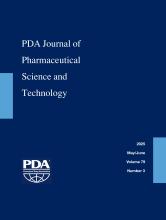Abstract
For biotherapeutics and vaccines, potency is measured in a bioassay which compares the concentration-response curves of a new batch to that of a reference standard. Acceptable accuracy and precision of potency measurement is critical to the manufacturing of these products. These characteristics of a bioassay are typically assessed in a procedure which is carried out with samples spanning the acceptable range for the product. During early development, however, a full validation study such as that which is carried out in late development can be costly as it relates to the likelihood of eventual program success. For these reasons the laboratory may look for alternative ways to ensure the validity of the bioassay across a range which will support product development. One such alternative combines information from a reduced procedure using only reference standard and 100% relative potency (RP) concentration-response data sets, together with computer simulation, to estimate missing RP values across the desired range. Fits to the reduced dataset provides estimates of bioassay model parameters such as those for an S-shaped potency assay which follows a four-parameter logistic relationship, along with estimates of their variance-covariance structure and independent experimental unit (e.g., well-to-well or animal-to-animal) errors. Using Bayesian Markov Chain Monte Carlo modeling, the predictive distribution of the concentration-response data for the desired levels of RP is generated. Results from use of the reduced procedure are compared to results which are calculated from a full dataset in Monte Carlo simulation and in a motivating example.
- Received June 21, 2017.
- Accepted January 11, 2018.
- Copyright © 2018, Parenteral Drug Association






